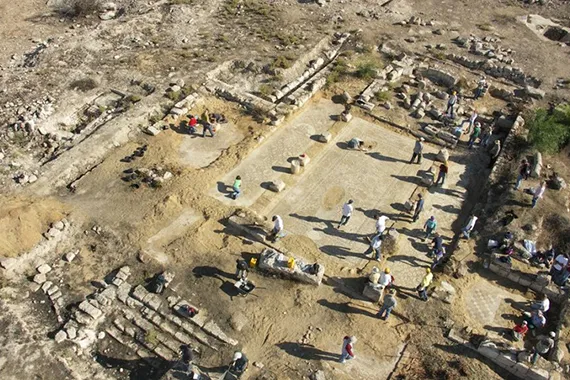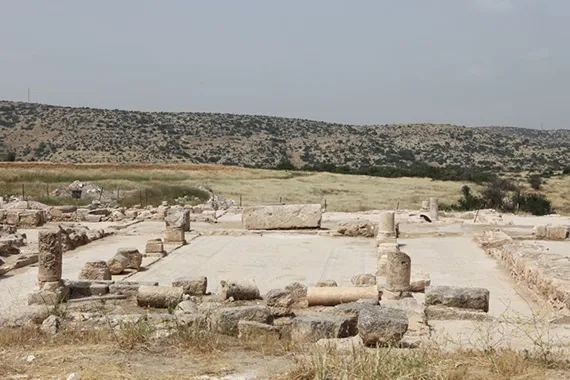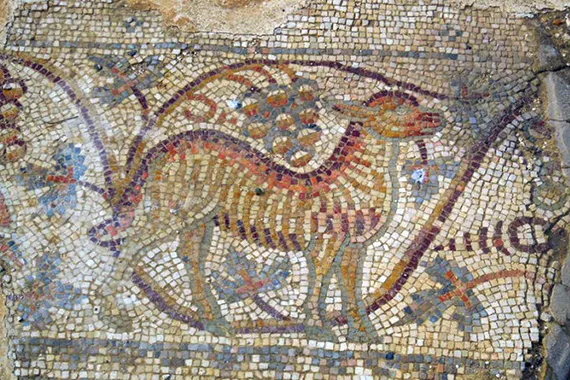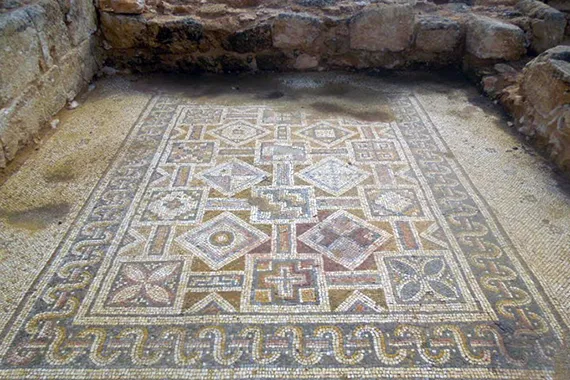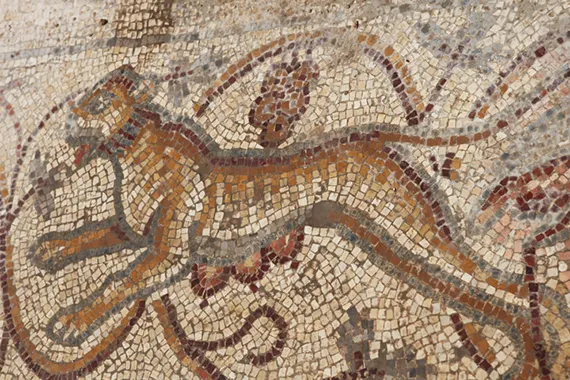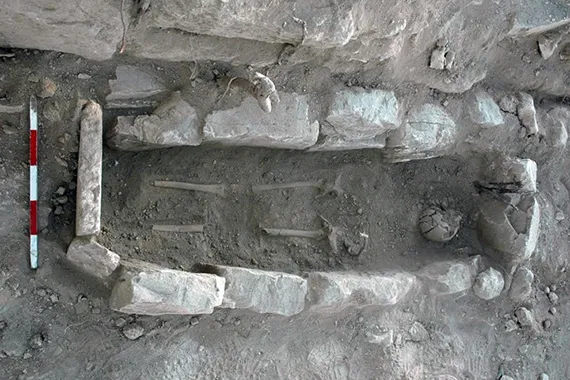
Byzantine Church
The Byzantine basilical church in the far western reaches of the site was the first major discovery after the Jerusalem Cave. The impressive church complex composed of the following: a basilica with ornate mosaic floors, a baptistery containing a basin surrounded by a marble screen, an oil press, a wine press, and a burial cave (crypt). In 2011, the renewed excavations at the site uncovered the church’s large stone-paved entrance courtyard (atrium), flanked by columns on all sides and featuring a deep-water cistern and connecting water basin. Patrons would stop at the atrium to wash their feet before entering the church. The atrium consists of a stone-paved entrance courtyard, measuring 65 x 100 feet which led to six steps to ascend to the chapel.
The entrance hall, called a “narthex” was generally brightly lit and full of movement in and out and led to the apse. The entrance chamber featured three doorways with the main hallway flanked by five columns on each side, dividing the chapel into three halls. Auxiliary rooms at the north and south included a baptistery and a hall with an altar, and other rooms for which the purpose remains unknown.
Apart from the atrium, the church is paved in its entirety with colorful mosaics featuring rich fauna, floral, and geometric designs, including a man laying his hands on the head of another, and a prominent image of two fishermen in a boat enclosed in a medallion. A total of four Greek inscriptions were also discovered in the mosaic floors: two were dedicatory in nature, while two are taken from Psalms. During the Muslim caliph in 724 AD it was deemed sacrilegious to have any face within a holy place. The result was the destruction of any image having a face. This also occurred at the Byzantine basilical church at Beit Lehi. Interesting though, instead of destroying the images a painstaking effort was undertaken to “rearrange” the tiles to make the faces indistinguishable. Thus, the spirit of the law was fulfilled without destroying the mosaics. The church and Christian community remained active during this period. A cemetery with 57 tombs from the Islamic period was found on the atrium.
In the floor of the baptistery room is a lead drain leading to a cistern. Finding a baptistery, large enough for baptism by immersion, is unusual. Adjacent to the church on the south and near the baptistery is an olive press. Olive presses are common, but to find one so near a Christian church is unusual. The baptistery has an oil and water pipe entering the room, again uncommon. To the north of the church a wine press and vat was discovered. It is believed that the Byzantine church was built on the remains of a more ancient structure. Such an undertaking to excavate under the church would be expensive and will need to wait until a later date.
Video
Video Transcript
The Byzantine church was founded around five hundred C.E. during the Byzantine, the Christian, period of the site of Beit Lehi. This is one of the biggest and most monumental buildings at the site. The church itself was divided into three parts.
The atrium, which was paved by stone slabs, had a water installation in its center. Up the stairs is the narthex, a corridor which divided the atrium from the courtyard and the basilica itself. On the upper part of the building there is a basilica, a nave paved with a beautiful mosaic floor and two aisles also paved with a beautiful mosaic floor decorated with the scene of a boat with fishermen, probably fishing in the sea of Galilee. The orientation of the church is toward the east like most of the Byzantine churches in the land of Israel. There’s a very nice apse where is located an altar and another two rooms to its side. On the southern part of the church there’s a large olive press and next to it a wine press.
So here we are at evening sitting on the Byzantine chapel floor with the columns going down both sides, and I’m sitting here in the front or the apse of the church. You’ll notice off to my left there’s a single step leading up to a platform and on my right two steps leading up to a platform. I think the church is symbolic in many different respects, but in this respect, I think this represents a lesser authority and the greater authority, and it’s represented right here within the mosaic floor as well as on these two altars to my left and to my right.
Virtual Tour
The virtual tour for this location works on your computer web browser as well as a tablet or a phone. Best of all, it works on your headset. For instructions using an Oculus Quest, please see our virtual visit page.
Image Gallery
